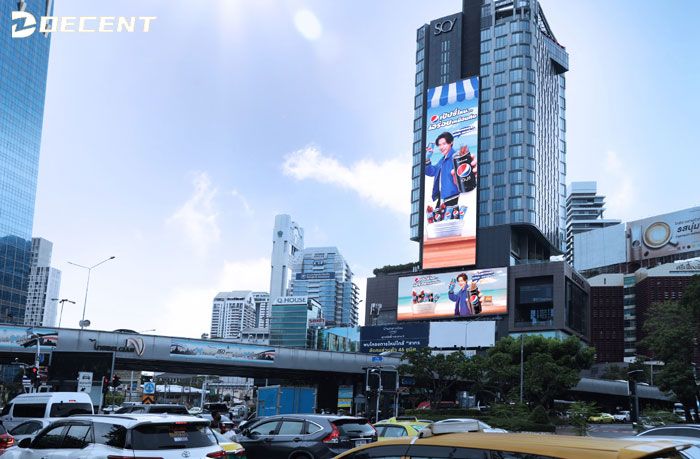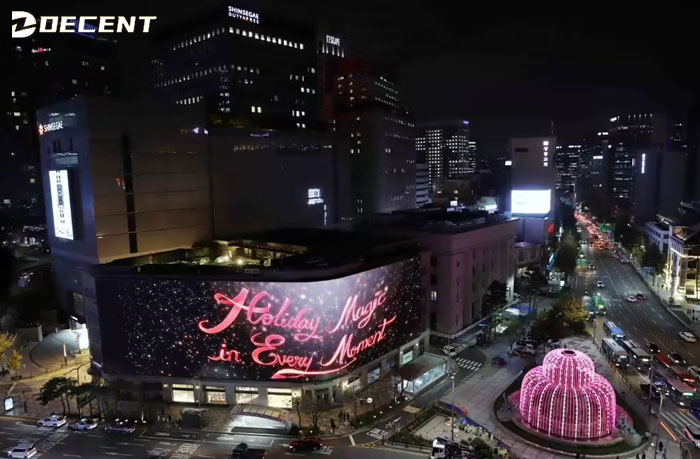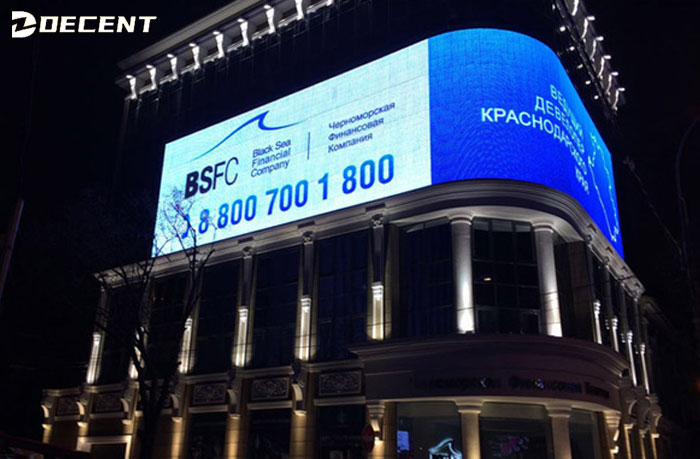



户外LED显示屏已经成为我们城市景观中无处不在的一部分,用充满活力的内容装饰建筑物,体育场馆和公共广场。随着它们越来越受欢迎,一个关键的问题出现了:它们对环境的影响是什么?户外LED显示屏与环境之间的关系是复杂的,既涉及显着的好处,也涉及重要的考虑因素。

与传统的照明和标牌解决方案相比,户外LED显示屏提供了几个引人注目的环境优势。
1. 能源效率和减少碳足迹
现代户外LED显示屏非常节能。它们将大部分电能转化为光能,很少浪费为热能。与白炽灯或荧光灯等老技术相比,这种效率是巨大的进步。对于企业和市政当局来说,这种较低的能源消耗直接转化为碳足迹的减少,特别是如果电力来自可再生能源。在大型显示器的使用寿命期间,累积的能源节省可能是可观的。
2. 减少光污染
这似乎有悖常理,但与传统的照明标牌相比,精心设计的户外LED显示屏确实有助于减少光污染。它们的主要优势是定向光和智能控制。与老式的向各个方向散射光线(造成“天光”)的标识不同,led可以精确瞄准。此外,它们可以与环境光传感器和计时器集成,在深夜自动变暗或在不需要时关闭,确保只在需要的时候和地方使用灯光。这种有针对性的方法最大限度地减少了不必要的光泄漏到夜空和周围区域。
3. 寿命延长和减少浪费
LED技术以其长寿命而闻名。一个高品质的户外LED显示屏可以有效工作100,000小时或更长时间。这种寿命意味着随着时间的推移,需要更换的部件更少。与印刷广告牌相比,印刷广告牌需要频繁的物理变化,乙烯基和纸张,或者传统的灯泡经常烧坏的标志,led产生的物理浪费要少得多。这减少了生产、运输和安装替代装置所需的原材料和能源的需求。

尽管它们具有优势,但户外LED显示屏的部署并非没有环境问题,必须负责任地进行管理。
1. 制造与资源利用
LED模组的生产涉及复杂的半导体制造过程,需要稀土元素和其他材料。这些材料的提取和加工有环境成本,包括能源消耗和潜在的栖息地破坏。负责任的采购和生产效率的提高对于减轻这种影响至关重要。
2. 电子废物和回收
在使用寿命结束时,户外LED显示屏变成了电子垃圾。如果处理不当,它们可能会加剧日益严重的全球电子垃圾问题。这些组件,包括金属、塑料和电子电路,需要负责任地回收,以回收有价值的材料,防止有害物质进入垃圾填埋场。该行业越来越关注于开发更好的回收协议,并设计更容易在报废时拆卸的显示器。
3. 负责任的灯光管理
如果显示器管理不当,潜在的光污染和分散注意力仍然是一个有效的担忧。过于明亮、闪烁或位置不佳的显示器会破坏当地的生态系统(影响夜行动物和昆虫),并导致人类睡眠障碍。遵守当地的亮度规定,使用自适应调光技术,并进行仔细的场地规划是可持续实施的基本做法。

户外LED显示屏的应用确实会对环境产生影响,但如果负责任地实施这项技术,它在很大程度上是积极的。它们的节能、长寿命和智能可控性使其成为比许多传统标牌更可持续的选择。
最终的环境影响取决于负责任的使用:选择节能模式,实施智能调光控制,确保在使用寿命结束时适当回收,并遵守社区关于照明水平的指导方针。如果使用得当,户外LED显示屏不仅仅是一个通信工具;它本身可以成为促进可持续发展和环保意识的平台。
 德珍科技是全球领先的LED显示屏供应商,为全球客户提供中高端LED显示设备及显控系统的研发、制造、工程安装和售后服务等整体解决方案。目前已发展成一个员工超1300人,拥有已授权国家专利400余项的国家级高新技术企业。公司先后获得安全生产许可证、钢结构施工资质、系统集成资质、建筑机电安装工程专业承包叁级、电子与智能化工程专业承包贰级。
德珍科技以“核心技术为本”定位,在LED行业深耕细作,在全球建立了众多营销中心及办事处、售后服务网点,公司产品遍布200多个国家和地区,累积完成经典案例超过40000个。强大的综合实力让德珍成为中石化、中石油、腾讯、阿里巴巴、华为、雅培等世界500强首选品牌。
德珍科技自成立以来沉淀了 10大行业首创技术、 43 项创新“黑科技”技术;并打造了专业显示、通用显示、会议显示、商用显示、户外显示、租赁显示6大产品线,应用于指挥监控、商显零售、广电演播、户外广告、体育赛事、舞台演艺等多个场景。产品质量在业内保持领先地位。
未来,德珍科技将继续秉持“产品+服务”的企业经营理念以及“创新、阳光、奋斗、感恩”的企业价值观,不断向着更高技术、更优服务、更硬质量迈进,致力于为每一位客户提供专业的LED显示系统解决方案。
德珍科技是全球领先的LED显示屏供应商,为全球客户提供中高端LED显示设备及显控系统的研发、制造、工程安装和售后服务等整体解决方案。目前已发展成一个员工超1300人,拥有已授权国家专利400余项的国家级高新技术企业。公司先后获得安全生产许可证、钢结构施工资质、系统集成资质、建筑机电安装工程专业承包叁级、电子与智能化工程专业承包贰级。
德珍科技以“核心技术为本”定位,在LED行业深耕细作,在全球建立了众多营销中心及办事处、售后服务网点,公司产品遍布200多个国家和地区,累积完成经典案例超过40000个。强大的综合实力让德珍成为中石化、中石油、腾讯、阿里巴巴、华为、雅培等世界500强首选品牌。
德珍科技自成立以来沉淀了 10大行业首创技术、 43 项创新“黑科技”技术;并打造了专业显示、通用显示、会议显示、商用显示、户外显示、租赁显示6大产品线,应用于指挥监控、商显零售、广电演播、户外广告、体育赛事、舞台演艺等多个场景。产品质量在业内保持领先地位。
未来,德珍科技将继续秉持“产品+服务”的企业经营理念以及“创新、阳光、奋斗、感恩”的企业价值观,不断向着更高技术、更优服务、更硬质量迈进,致力于为每一位客户提供专业的LED显示系统解决方案。 您有什么问题或要求吗?
点击下面,我们很乐意提供帮助。 联系我们